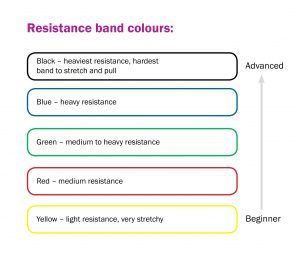A number of scientific studies have shown that resistance or strength training is beneficial in slowing the cognitive and physical decline of people suffering with dementia.
At the bottom of this page are videos which show you how to do seated exercises using a resistance band which aim to improve your upper and lower body strength. This provides benefits for walking, climbing stairs, standing from a chair, holding items in your hands and co-ordination of your arms and hands in daily tasks.
What equipment do I need?
You will need a resistance band to perform this workout. You can use different grades of resistance band depending on your current strength. The colour of the band denotes how much resistance the band has.
How many times should I repeat each exercise?
The number of times you repeat each exercise will depend on your comfort. Repeat the exercise as many times as you can and aim to increase this number each time. To begin with, complete the exercise once and increase this gradually, aiming to repeat the exercise 10 to 12 times (if you feel comfortable doing so).

How much rest should I take?
Rest for 60 to 90 seconds between each exercise or set of exercises. You can reduce your rest period to make your workout more difficult as you progress.
Can I make the exercises easier or harder?
Simply increase the length of the band from from the resistance point to make the exercise easier, or reduce the length of the band from the resistance point to make the exercise harder. Alternatively, you can choose a band that has increased resistance. You can also make an exercise harder by pausing half way, holding the position for a few seconds and then resuming the exercise.
Things to remember:
- Do a brief warm up before you start – a brief three to five minute walk and some shoulder rotations will raise your body temperature and heart rate slightly.
- For maximum benefits count to two when you are working against the resistance of the band and count to four when you are working with the band. You should always be in control of the band – not the other way round!
- Hydration is important – make sure you are well hydrated before you start and have a glass of water to hand in case you get thirsty.
- Wear comfortable, loose-fitting clothes that allow you to move freely.
- If you have an existing medical condition it is best to consult your GP before undertaking any new exercise regime.
- Resistance bands can contain latex, if you have an allergy make sure you use a latex free band.
Tummy rotation
Make sure you keep your back as straight as possible and rotate from the waist.
Keep your wrists fixed to avoid stress on your wrist joints.
If you have any lower back issues consult your GP before doing this exercise.
Straight arm pull
As you pull the band upwards make sure you do not lean forward in your chair.
Aim to get your arms to shoulder height but always work within your pain free range. Make sure you do not ‘lock out’ your elbows.
Cross and pull
Try to avoid leaning forward in your chair.
As you straighten your arms try and slow the movement down and avoid ‘locking out’ your elbows
Leg press
If you have any hip or knee problems consult your GP before beginning this exercise.
You can reduce the stress on your knees and hips by keeping your foot in contact with the floor, try doing this with socks on so your foot can slide more freely along the floor.
This workout is also available in our Couch potatoes for cognition booklet.
The information on this page is based on research by the Dementia Research Group at Loughborough University.